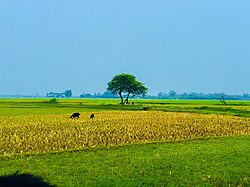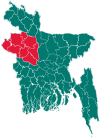Tarash Upazila
Tarash
তাড়াশ | |
|---|---|
 | |
 | |
| Coordinates: 24°26′N 89°22.5′E / 24.433°N 89.3750°E | |
| Country | |
| Division | Rajshahi |
| District | Sirajganj |
| Area | |
• Total | 300.07 km2 (115.86 sq mi) |
| Population | |
• Total | 211,853 |
| • Density | 710/km2 (1,800/sq mi) |
| Time zone | UTC+6 (BST) |
| Postal code | 6770[2] |
| Area code | 07528[3] |
| Website | Official Map of Tarash |
Tarash[a] is an upazila, or sub-district of Sirajganj District, located in Rajshahi Division, Bangladesh.[4]
Geography
Tarash is located at 24°26′00″N 89°22′30″E / 24.4333°N 89.3750°E. It has 48,941 households and total area 300.07 km2. The upazila is bounded by Sherpur upazila of Bogra district on the north, Bhangura and Chatmohar upazilas of Pabna district on the south, Raiganj and Ullahpara upazilas on the east, Gurudaspur and Singra upazilas of Natore district on the west.[5]
Demographics
According to the 2011 Census of Bangladesh, Tarash Upazila had 48,941 households and a population of 197,214. 46,610 (23.63%) were under 10 years of age. Tarash had a literacy rate (age 7 and over) of 38.98%, compared to the national average of 51.8%, and a sex ratio of 1024 females per 1000 males. 8,442 (4.28%) lived in urban areas.[7] Ethnic population was 9,498 (4.82%), mainly Oraon and Mahato.[8]
As of the 1991 Bangladesh census, Tarash has a population of 135435. Males constitute are 50.21% of the population, and females 49.79%. This Upazila's eighteen up population is 68421. Tarash has an average literacy rate of 22.6% (7+ years), and the national average of 32.4% literate.[9]
Administration
Tarash, primarily formed as a Thana, was turned into an upazila in 1983.[5]
Tarash Upazila is divided into Tarash Municipality and eight union parishads:Talam, Baruhas, Deshigram, Madhainagar, Magura Binod, Naogaon, Saguna, and Tarash. The union parishads are subdivided into 171 mauzas and 254 villages.[7]
Notable people
See also
- Upazilas of Bangladesh
- Districts of Bangladesh
- Divisions of Bangladesh
- Thanas of Bangladesh
- Union councils of Bangladesh
References
- ^ National Report (PDF). Population and Housing Census 2022. Vol. 1. Dhaka: Bangladesh Bureau of Statistics. November 2023. p. 402. ISBN 978-9844752016.
- ^ "Bangladesh Postal Code". Dhaka: Bangladesh Postal Department under the Department of Posts and Telecommunications of the Ministry of Posts, Telecommunications and Information Technology of the People's Republic of Bangladesh. 21 October 2024.
- ^ "Bangladesh Area Code". China: Chahaoba.com. 18 October 2024.
- ^ Newaz, M. G (2012). "Tarash Upazila". In Sirajul Islam; Miah, Sajahan; Khanam, Mahfuza; Ahmed, Sabbir (eds.). Banglapedia: the National Encyclopedia of Bangladesh (Online ed.). Dhaka, Bangladesh: Banglapedia Trust, Asiatic Society of Bangladesh. ISBN 984-32-0576-6. OCLC 52727562. OL 30677644M. Retrieved 31 January 2025.
- ^ a b M.G Newaz (2012), "Tarash Upazila", in Sirajul Islam and Ahmed A. Jamal (ed.), Banglapedia: National Encyclopedia of Bangladesh (Second ed.), Asiatic Society of Bangladesh
- ^ Population and Housing Census 2022 - District Report: Sirajganj (PDF). District Series. Dhaka: Bangladesh Bureau of Statistics. June 2024. ISBN 978-984-475-229-0.
- ^ a b "Bangladesh Population and Housing Census 2011 Zila Report – Sirajganj" (PDF). bbs.gov.bd. Bangladesh Bureau of Statistics.
- ^ "Community Tables: Sirajganj district" (PDF). bbs.gov.bd. Bangladesh Bureau of Statistics. 2011.
- ^ "Population Census Wing, BBS". Archived from the original on 2005-03-27. Retrieved November 10, 2006.
External links
- এক নজরে তাড়াশ (in Bengali)
Notes
